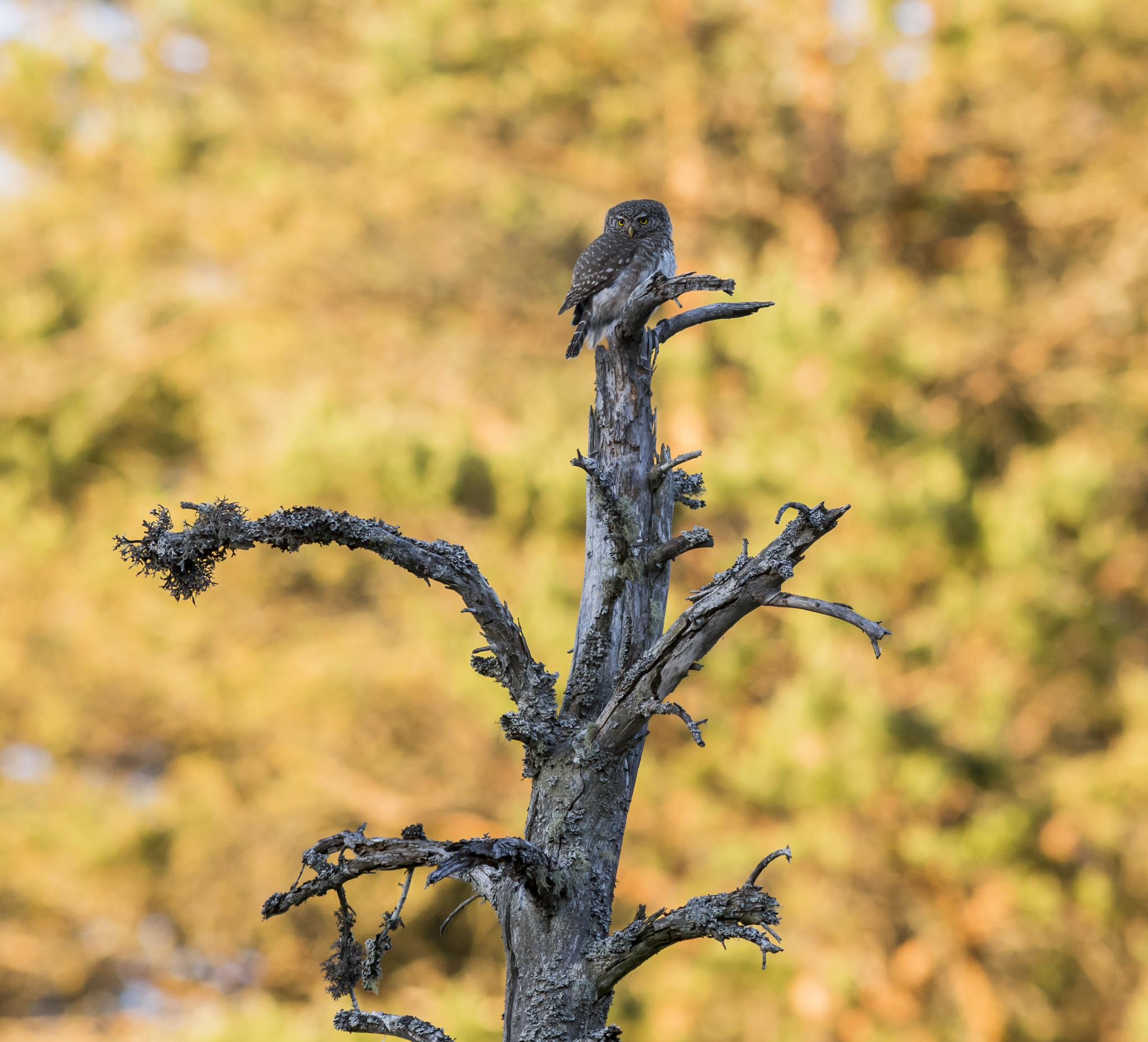That’s an excellent choice. The Eurasian Pygmy Owl (Glaucidium passerinum) is one of Europe’s most captivating raptors, primarily due to its diminutive size and unique ecological niche.
Here is a deep review of this remarkable “little devil.”
🦉 Eurasian Pygmy Owl (Glaucidium passerinum) Deep Review
1. Description and Identification
The Eurasian Pygmy Owl is the smallest owl in Europe. Its scientific name, passerinum, is derived from Latin, meaning “sparrow-like,” which speaks to its tiny size.
| Feature | Detail |
| Size | Length: 15–19 cm (6–7.5 in). Weight: Males 50–65 g, Females 67–77 g. It is roughly the size of a Starling. |
| Plumage | Dark rufous-brown to greyish-brown upperparts, heavily spotted with buffy-white spots. Underparts are whitish with dark brown streaking/barring. |
| Head | Small, rounded, and lacks ear tufts (a key difference from many other owl species). Eyes are bright yellow. |
| “False Face” | A crucial field mark: it has a pattern of black and white markings on the back of its neck (the nuchal region) that mimic a pair of eyes. This “false face” is believed to deter predators and competing small birds from attacking the owl from behind. |
| Feet/Talons | Despite its small size, it has disproportionately large, powerful feet and talons, enabling it to successfully catch and carry prey up to its own size, such as large thrushes or even small woodpeckers. |
| Sexual Dimorphism | Females are slightly larger and heavier than males. |
2. Habitat and Distribution
- Geographic Range: Widespread across the Palearctic region, from Scandinavia and the mountainous regions of Central and Southern Europe (Alps, Carpathians, Rila) eastward across the Siberian taiga to Northeast China.
- Habitat: Primarily a bird of mature, extensive coniferous or mixed boreal forests (taiga), often found at higher elevations (montane forests). It prefers forests with plenty of dead wood and clearings, frequently near water sources.
- Nesting: As a cavity nester, it relies almost entirely on old nest holes excavated by woodpeckers (especially the Great Spotted Woodpecker) or natural tree cavities. It readily uses human-provided nest boxes. The nest is typically located 1–13 meters above the ground.
- Residency: Adults are largely sedentary and non-migratory, remaining in their territories year-round. Young birds may disperse in autumn and winter, especially during periods of low prey availability or harsh weather.
3. Behavior and Hunting
Activity Pattern (Crepuscular and Diurnal)
Unlike many European owls, the Pygmy Owl is not strictly nocturnal. It is most active during the crepuscular hours (dawn and dusk), but is often seen and heard hunting during the daytime, especially in winter or when feeding young.
Hunting Strategy
It is primarily a sit-and-wait ambush predator.
- Mammalian Prey: When hunting small mammals (voles, mice, shrews), it typically perches high and close to the ground, flying down quickly to pounce on its prey.
- Avian Prey: When hunting birds, it uses higher perches and attacks its prey, often catching small passerines in mid-air or ambushing them on exposed branches.
Diet and Hoarding (Caching)
The Pygmy Owl is a generalist predator with a seasonal shift in diet:
- Summer Diet: Primarily small mammals, particularly voles (Bank Vole, Field Vole) and mice, along with a substantial percentage of small birds (passerines).
- Winter Diet: The diet shifts to rely more heavily on small birds, such as tits, finches, and goldcrests, which are more visible and active during the day.
- Caching Behavior (Larders): A unique survival strategy is food hoarding. In late autumn and winter, the owl actively stocks up its food reserves in tree holes and nest boxes, often storing dozens, sometimes over a hundred, of small mammals and birds. This cache is crucial for survival during poor weather or times of scarcity.
4. Reproduction and Conservation
- Breeding: Pairs are generally monogamous and may use the same nest territory for several years. Courting begins in autumn/early spring, marked by the male’s advertising song—a clear, monotonous series of soft, fluted whistles.
- Clutch Size: The female lays 4–8 eggs, which are incubated mainly by her. The male is responsible for provisioning the female and later the young.
- Conservation Status: Least Concern (LC) globally. However, its reliance on mature, old-growth forests (especially those with woodpecker activity) makes it vulnerable to intensive modern forestry practices. Conservation efforts often focus on protecting these habitats and providing suitable nest boxes.
Views: 1612
Subscribe to the newsletter:
